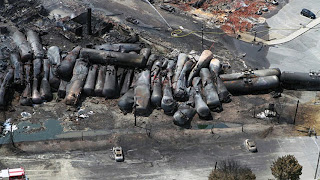As the smoke clears in Lac-Megantic, Quebec after a runaway train packed with crude oil tankers crashed, the oil industry is coming to terms with a business that has perhaps grown too far, too fast.
The
Lac-Megantic accident is shining an unwelcome spotlight on the lack of
regulatory oversight on oil by rail in both the US and Canada. The fact that
the rail cars (belonging to the Maine, Montreal & Atlantic rail
company) that crashed and exploded were considered unfit to carry hazardous
materials sharpens that focus.
Getting
landlocked crude out of newer fields in North Dakota, Canada and other far
flung parts of North America has become an obsession with producers, traders –
and with refiners, looking lustfully at the cheaper feedstock.
The
oil rush has changed the face of rail in North America. In a country where
passenger and cargo-bearing rail was largely replaced by the car and large
18-wheel trucks half a century ago, the speed with which new railroad lines,
railcars and loading facilities are being built is simply astonishing.
Today
around one million barrels per day of crude oil is moved via rail across the US
and Canada. To put that into perspective, it equates to more than the total output
of the UK North Sea, which fell below 1.0m b/d last year. Or roughly to four
VLCC’s worth of crude oil every week. In other words, it is a lot of oil.
And
this is set to grow. In the US, crude by rail shipments are expected to reach
to near 1.10 million b/d at the end of 2014, up from about 718,000 b/d this
month and about 156,000 b/d in January of 2012, according to Bentek Energy, a
division of Platts.
The Railway Association of Canada estimated that
as many as 140,000 carloads of crude, totaling about 91 million barrels, will
be shipped on Canadian tracks this year, compared with 500 carloads, or about
325,000 barrels, in 2009.
The headlong dive into crude by rail may have
just been stopped short by the Lac-Megantic incident. And, just as the Exxon
Valdez oil spill in Alaska in 1989 spelled the end of single-hull oil tankers
coming to the US (and banned them worldwide in 2010), the Lac-Megantic crash
would spell the end of using DOT-111A railcars. And it could herald a new rash
of regulation for the rail industry.
A US National Transportation Safety Board
study in 2012 said that 69% of tank cars are DOT-111A. In Canada, these are
known as CTX-111A, and comprise 80% of the fleet, according to Canada
Transportation Safety Board’s chief investigator
Donald Ross.
Ross
said that changes as a result of the MM&A investigation could include
thicker steel or shields for the tank cars. The American NTSB had already
changed the specifications of DOT-111 from October, 2011 to include thicker
shells and a ½ inch thick head shield. But there is no rule on retrofitting
existing cars, which have a long service life.
Like
the single-hull tanker post-Exxon Valdez, DOT-111As could be the next casualty
of the oil rush in North America.
But
there are other issues raising their ugly heads, including the state of some of
the railroad tracks around both countries: While the oil industry is spending
billions on railcars and loading/unloading facilities, who is spending the
money to maintain and upgrade the railroads?
As
Avrom Shtern, a rail-transport policy representative with Montreal-based Green
Coalition, said in Oilgram News July 9: The Canadian government's budget cuts
have left the rail industry to police itself. "That's unacceptable. You
can't just write rules and expect the railways to police themselves," he
said.
Also,
questions over the capital adequacy of smaller gathering and distribution
companies such as World Fuel, which owned the oil on board the MM&A train, and
others are rife. Will they have the financial stability to survive a lawsuit?
The
crash was only a few days ago, so most of these questions will be answered over
time. But one thing is for sure, crude by rail has come a long way fast. But the
Quebec accident could slow the pace and the way in which the industry grows
going forward in both Canada and the US.

No comments:
Post a Comment